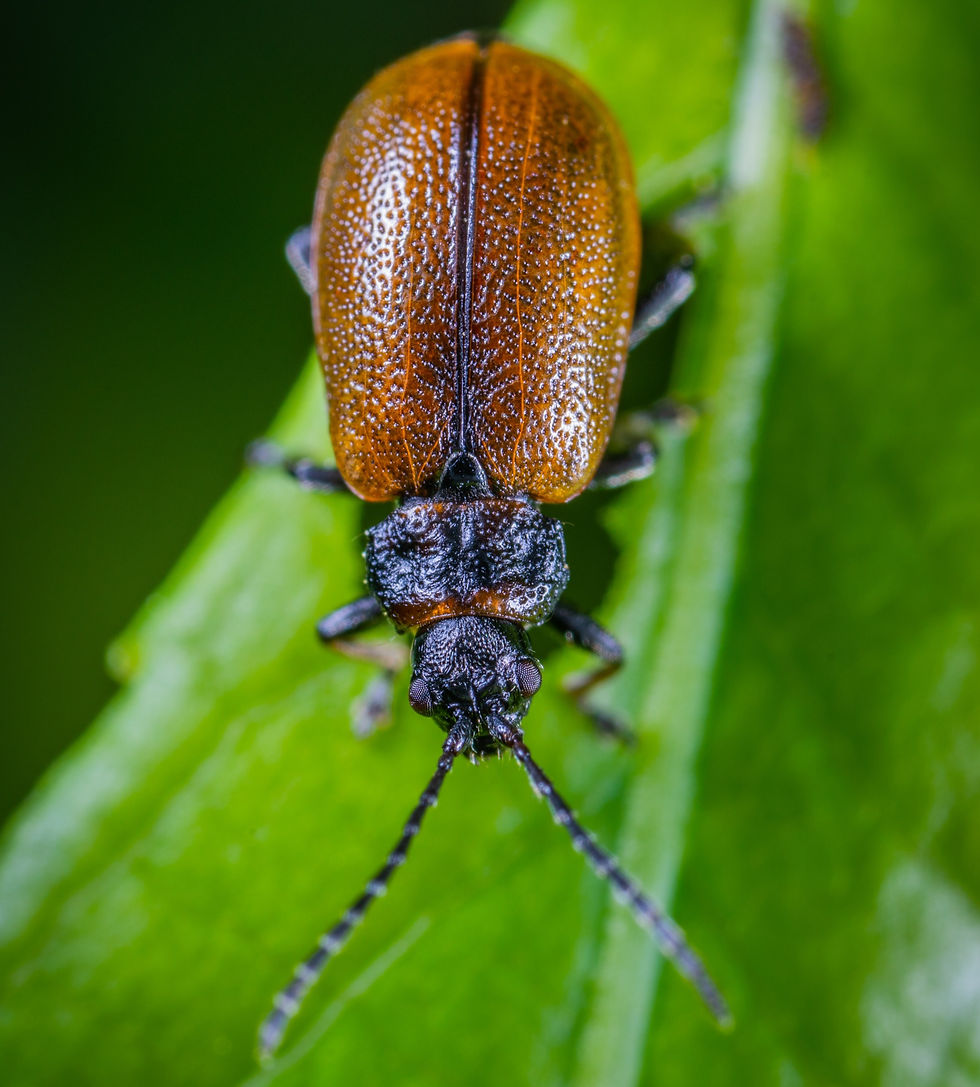June Bugs in Your Garden
- Edgar Romero Gonzalez

- Jun 29, 2022
- 3 min read
by: Edgar Romero Gonzalez, City Sprouts South Manager + Assistant Educator

Ah, summer. It's the time of year where we can celebrate the Summer Solstice, hot days, pool parties, and cookouts! However, something rather peculiar also happens around this time. We begin to see June bugs in large numbers.
So, what is a June bug?
Let's start by better understanding the name. "June bug" is more of a generic name that refers to any of the hundreds of scarab beetle species under the Phyllophaga genus within the Melolonthinae subfamily in the animal kingdom. The name Phyllophaga is derived from the Greek words phyllon (leaf) and phagos (eater). The reason we've come to know these beetles as a "June bug" is due to the fact that the adult beetles emerge from the soil during the end of spring and beginning of summer.
Their life cycle is generally about 1 year. Females bury their eggs (1st life stage) just below the surface around midsummer. These eggs hatch into white grubs (2nd life stage) after about 3-4 weeks. These grubs then go on a feeding frenzy for the next few months or, in some cases, up to 3 years! They have a taste for grass and plant roots. (Ugh, I know!) They keep eating to plump up as much as possible so they can then grow into pupae (3rd and final life stage) and emerge the following year. This process is similar to what a caterpillar does before it becomes a butterfly.
Are they harmful?
If you're a human, these beetles are pretty harmless. If you're a plant, it can get pretty ugly. As mentioned earlier, the grubs are bad news for grass and plant roots. The obvious indication of grub presence in your lawn is the appearance of poorly grown patches of grass that brown and yellow during dry weather. Think your garden is safe because you're not growing grass? Ha! A large presence of grubs in your garden can make a buffet out of your plant's roots. Plants become stunted, wilted, and may even start losing their leaves no matter how much you water and/or fertilize! I've seen lettuce planted nicely in a row fall one by one as the season progresses. Like I said, it's a buffet! These grubs simply move on to the next plant down the line once they're done with the first plant. The adult beetles favor tree and shrub leaves. Again, bad news for plants.
How to Keep June bugs in Check
It's surprisingly simple to prevent June bugs from getting out of hand and you don't have to use harsh chemicals. Check it out!
Wage War on the Grubs Dealing with slow moving grubs is easier than trying to deal with the beetle once it's airborne. You can introduce natural predators in the form of beneficial nematodes (microscopic parasitic worms) into your lawn and garden. These can be easily purchased at your local garden store or online.
Use Bacillus thuringiensis (commonly known as BT) This bacterium is toxic to a large number of undesirable garden pests, but it's not toxic to humans or pets. This can also be easily purchased at your local garden store.
Use a Homemade Trap for Adult June Bugs Fill a large jar with a 1/2 cup of molasses and 1/2 cup of water, mix well, and simply bury the trap into the soil so that the top of the jar is just above the soil. Place the trap near the plant, shrub, or tree that is being attacked by the adults. You'll have to check and refill the trap each morning to make it effective.
Request Backup in the Form of Natural Predators - Amen for mother nature! It's known that reptiles (lizards and snakes), birds, and amphibians (frogs and toads) like to eat June bugs. Adding bird baths and feeders into your garden/yard will encourage birds to stop by. Adding shallow dishes of water and creating cool/dark places in your garden/lawn will welcome lizards and amphibians. Keep in mind that standing water can also be a mosquito heaven! So make sure you're not creating a new problem by trying to solve your current problem.
Let Us Know!
How do you deal with June bugs each year? Do you have a preferred method of managing these pests? Let us know! Email info@omahasprouts.org.
--
Questions about these pests, or others? Email Edgar Romero Gonzalez at (edgar@omahasprouts.org).




<a href="https://aideredaction.com/correcteur-tfe-infirmier">good job</a>
<a href="https://rédacteurmémoire.com/aideredactionnotederecherchesoinsinfirmiers">it is very important</a>
The advisors identified critical projects involving experimentation and problem-solving that met the R&D criteria. With Swanson Reed’s support, swansonreed.com.au the firm secured financial benefits that enabled them to invest in new equipment and expand their service offerings to a broader client base.
In the midst of the labyrinth of specialized work, it is very normal for doctoral understudies to miss out on consummating the gathering of their work. https://www.expertmemoire.com/ They might neglect to see a portion of the incorrect deficiencies which in the long run delay getting their certificate.